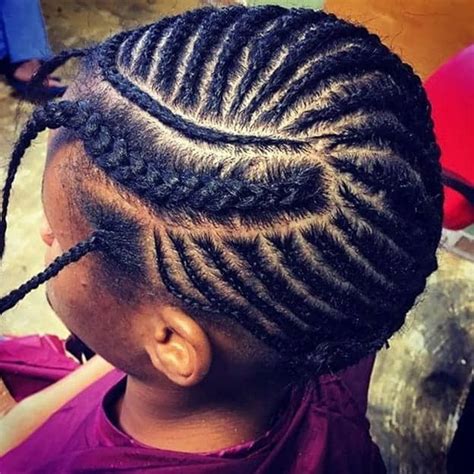Elevate your crown with sew-in braid patterns that redefine the art of protective styling. Whether you seek stunning volume, intricate designs, or a touch of versatility, this guide delves into the versatile world of sew-in braids, empowering you to achieve the look you desire.

Understanding Sew-in Braids
Sew-in braids are a form of protective hairstyling that involves attaching synthetic or natural hair extensions to your natural hair using a needle and thread. This technique allows for the creation of intricate braids, cornrows, and other hairstyles that blend seamlessly with your own hair.
Benefits of Sew-in Braids
Millions of hair enthusiasts have embraced sew-in braids for their numerous benefits, including:
- Protective: Shield your natural hair from damage caused by styling, heat, and chemicals.
- Versatile: Experiment with diverse braid patterns, lengths, and colors to suit any occasion.
- Long-lasting: Enjoy weeks or even months of hassle-free styling without the need for frequent touch-ups.
- Customizable: Tailor your braids to your unique hair texture, length, and desired look.
- Convenient: No need to spend hours styling your hair every day; sew-in braids offer a low-maintenance solution.
Choosing the Perfect Pattern
The key to a stunning sew-in braid style lies in selecting the right pattern. Consider these factors:
- Face shape: Determine your face shape to choose patterns that complement your features.
- Hair type: Select patterns that are suitable for your natural hair texture.
- Desired style: Whether you prefer sleek cornrows, voluminous box braids, or intricate Ghana braids, the pattern will shape your look.
- Occasion: Choose patterns that are appropriate for different occasions, from casual outings to formal events.
Comprehensive Sew-in Braid Patterns
1. Box Braids
- Type: Square-shaped braids that create a bold, geometric look.
- Variations: Jumbo box braids, micro box braids, and mid-length box braids.
- Best for: All hair types, especially thick or coarse hair.
2. Cornrows
- Type: Raised, three-strand braids that run parallel to each other.
- Variations: Traditional cornrows, zigzag cornrows, and goddess cornrows.
- Best for: All hair types, particularly fine or relaxed hair.
3. Ghana Braids
- Type: Intricate, overhand braids that form a braid within a braid.
- Variations: Two-strand Ghana braids, four-strand Ghana braids, and Zulu knot braids.
- Best for: Natural hair types, especially those with tight curls or coils.
4. Tribal Braids
- Type: Cultural braids inspired by various African tribes.
- Variations: Zulu braids, Fulani braids, and Masai braids.
- Best for: Natural hair types that can hold intricate patterns.
5. Flat Twist Braids
- Type: Twisted braids that lie flat against the scalp.
- Variations: Two-strand flat twists, Havana twists, and Senegalese twists.
- Best for: All hair types, particularly natural hair with shrinkage.
Step-by-Step Guide to Installing Sew-in Braids
Materials:
- Synthetic or natural hair extensions
- Curved needle
- Thread
- Rattail comb
- Hair clips
- Mousse or gel
Steps:
- Prepare your hair: Detangle and wash your hair. Apply mousse or gel to create a smooth base.
- Section your hair: Divide your hair into small sections using hair clips.
- Attach the extensions: Thread the needle with the extension hair and sew it to your natural hair close to the root.
- Braid the extensions: Continue sewing and braiding the extensions until you reach the desired length.
- Seal the ends: Tie off the loose ends with thread and apply glue or wax for extra hold.
Tips for Long-Lasting Sew-in Braids
- Cleanse gently: Use a sulfate-free shampoo and avoid excessive washing.
- Moisturize regularly: Apply oil or moisturizer to the braids to prevent dryness and frizz.
- Wrap your hair at night: Protect your braids by wearing a satin bonnet or scarf.
- Avoid heat: Limit the use of heat styling tools on your braids.
- Touch up as needed: Tighten any loose sections or re-sew the braids to maintain the desired look.
Frequently Asked Questions (FAQs)
-
Can sew-in braids damage my natural hair?
– Proper installation and maintenance techniques can prevent damage. Avoid tight braiding or leaving braids in for an extended period. -
How long do sew-in braids last?
– With proper care, sew-in braids can last for 6-8 weeks. -
Are sew-in braids suitable for all hair types?
– Sew-in braids can be customized for all hair types, including natural, relaxed, or chemically treated hair. -
Can I style my sew-in braids?
– Yes, you can style your sew-in braids by adding beads, accessories, or heatless techniques like Bantu knots or flexi rods. -
How can I remove sew-in braids safely?
– Use a seam ripper or cutting pliers to carefully remove the thread from the braids. Avoid pulling or cutting the hair. -
Are sew-in braids expensive?
– The cost of sew-in braids depends on the length, pattern, and type of hair extensions used. Prices can range from $200 to $800. -
Can I install sew-in braids myself?
– It’s recommended to have a professional install sew-in braids to ensure proper technique and avoid damage. -
How often should I get my sew-in braids touched up?
– Touch-ups are typically needed every 4-6 weeks to tighten loose sections and maintain the braid pattern.
Conclusion
Sew-in braid patterns offer boundless possibilities for expressing your creativity and elevating your hairstyle game. By understanding the different patterns, following the installation steps, and adhering to the maintenance tips, you can achieve stunning, long-lasting braids that protect and enhance your natural beauty. Embrace the artistry of sew-in braids and let your hair be the canvas for endless style transformations.
